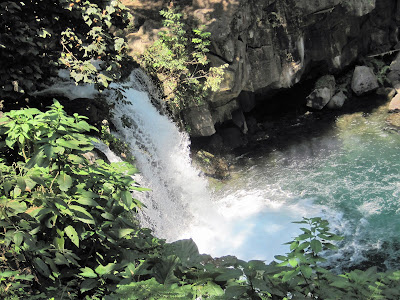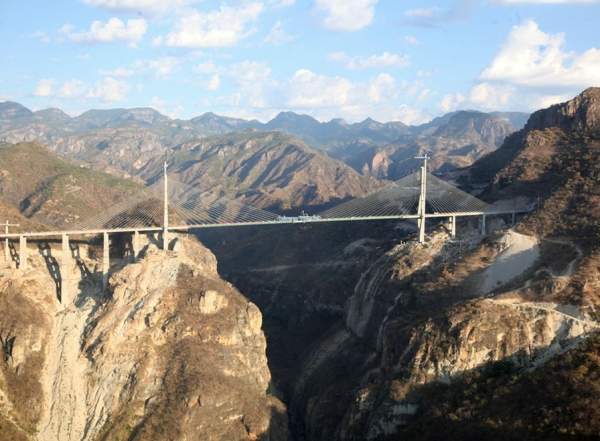The 13 hour crossing from La Paz to Mazatlan was very calm and our cabin was quite pleasant so we even got some sleep. The resort town was founded in 1531 and has sandy beaches of 21km along the malecon or boardwalk.
The pyramid-shaped hill to the right is Cerro del Creston and has a lighthouse on top
We enjoyed walking around the old town and seeing all the lovely architecture, including the towering Immaculate Conception basilica.
The best way to see Mazatlan is from El Faro Lighthouse on the top of Cerro del Creston. Its the highest lighthouse in the Americas and even though the hike is only about half a mile, the final part is more than 350 steep steps. It was worth it for the view from the top.
From Mazatlan we travelled to Durango, across the Sierra Madre mountains which are some of the highest in Mexico and extremely steep. We had planned on taking the relatively new toll road there, with its 115 bridges and 63 high altitude tunnels but a truck had caught fire on the Baluarte Bridge mid January, and now authorities are saying it's going to take 7 months to repair. Bearing in mind that the bridge has a vertical clearance of 1,300 feet from the riverbed and is 3,600 foot long, its the highest cable-stayed bridge in the world and one of the longest too.
(photo courtesy of Road Traffic Technology)
Needless to say, we didn't get to see it or most of the new road and did the drive both ways on the old road, also known as Espinozo del Diablo or the Devil's backbone. I didn't know that it was one of the most dangerous roads in the world, until we got to Durango and Mark showed me the link below:
http://www.dangerousroads.org/north-america/mexico/63-espinazo-del-diablo-mexico.html
The views along the way made the drive worthwhile
The city of Durango was founded by the Spanish in 1563 and the architecture is absolutely beautiful and characterised as 'eclectic with elements resembling Barcelona, Madrid, Paris and Florence'. With so many old buildings and a church on nearly every corner, the "Catedral Basilica de Durango" is in the heart of the city and is considered to be the most beautiful building in northern Mexico.
Next stop, the little town of El Rosario. The town is famous for the alter in the local church, which is made of gold. El Rosario was once the richest town in northwest Mexico because of its mining operations.


When we were in La Paz, our neighbours gave us a list of places to visit so we headed to the coastal town of San Blas. We hadn't investigated why we should visit, so it came as quite a surprise to discover that the port of San Blas was formerly founded on 22nd February 1768 and the town was celebrating its 250 year anniversary that day. That evening we sat in the town square with hundreds of local families and enjoyed singing, folk dancing and other festivities. It is also the port where Father Junipero Serra set sail for the Californias and founded 17 missions, the first one being in Loreto on Baja (which we also visited when we were there). In the late 18th century, San Blas was one of the busiest ports and ship building centres on the Pacific coast of the Americas, but the bay was too small and climate's humidity and torrential rains (bringing mosquitoes and sickness) meant it didn't last. A hillside fort was built in 1770 to defend the town's large sea trade with the Philippines, and behind it are the ruins of the Church of Our Lady of the Rosary, build in 1769.




On to Puerto Vallarta, a resort town on Mexico's Pacific coast. I found a nice little apartment up in the hills, only 5 minutes from the beach and old town. This was the view from our balcony
and one of the famous beaches
After a few days in PV, we headed inland to Guadalajara and the cultural centre of Mexico. I found a very large apartment in the historic centre, just a few blocks from the Cathedral, and it has been the perfect base for us to spend the week here. There are many squares, public parks, sculptures and of course, churches.
We did a day trip to Tequila (well, it would have been rude not to) and visited the Fortuna brewery on the way. We toured the Tres Mujeres (Three sisters) distillery, learnt all about how tequila is made (from the root of the agave plant) and did a little tasting. The aged tequila is more like a whiskey/bourbon and doesn't smell like jet fuel either. We had some free time to look around the town, so I left Mark absorbing the atmosphere in the town square, while I went off exploring.
I found the Jose Cuervo hacienda and just wandered in for a look and ended up in the tasting room talking in my limited Spanish to the old chap behind the bar, who was more than happy to pour a few samples for me :-)
I'm not sure what was happening here but these local flute players flung themselves off their pole and spun all the way down.
We have really enjoyed Guadalajara and I would be quite happy spending more time here but it is time to move on. Tomorrow we head to Lake Chapala then back to the coast and work our way down to Zihuatanejo













































































